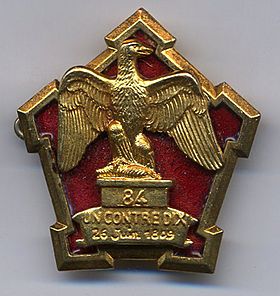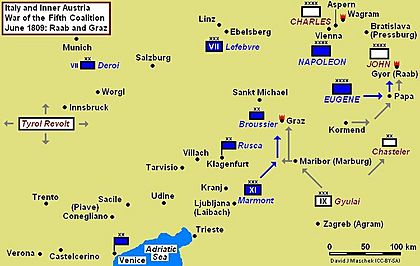Battle of Graz facts for kids
Quick facts for kids Battle of Graz |
|||||||
|---|---|---|---|---|---|---|---|
| Part of the War of the Fifth Coalition | |||||||
 84th Line Infantry Regiment insignia showing the inscription UN CONTRE DIX 26 Juin 1809 |
|||||||
|
|||||||
| Belligerents | |||||||
| Commanders and leaders | |||||||
| Strength | |||||||
| 15,000 20,000 22,000 |
5,000 6,000 |
||||||
| Casualties and losses | |||||||
| 980-2,000 | 263-900 | ||||||
The Battle of Graz was a series of fights that happened between June 24 and 26, 1809. It was part of the War of the Fifth Coalition. This battle involved Austrian soldiers led by General Ignaz Gyulai and French soldiers led by General Jean-Baptiste Broussier. Later, more French troops under General Auguste Marmont joined the fight.
Even though the Austrians managed to get supplies to their soldiers in the Graz fortress, the French eventually won. They pushed the Austrian forces away from the city. Graz is a city in Austria, located about 145 kilometers (90 miles) southwest of Vienna.
Before another big battle called the Battle of Raab on June 14, the French army had left Broussier's soldiers to surround the Austrian fortress in Graz. When General Gyulai's Austrian army showed up, Broussier's troops had to pull back. This allowed the Austrians to deliver much-needed supplies to their soldiers inside the fortress.
On the night of June 25, Broussier sent two groups of soldiers from the 84th Line Infantry Regiment into Graz. These soldiers were on their own, without backup. They were quickly surrounded by many more Austrian soldiers. Despite being outnumbered, the French fought bravely. They held their ground until the next afternoon before finally breaking out of the encirclement.
Soon after, General Marmont's French army arrived and joined the 84th Regiment. Marmont then attacked and forced Gyulai's Austrians to leave Graz. However, the Austrian soldiers still held the castle hill. After this, Emperor Napoleon I called both Marmont and Broussier to Vienna. They both took part in the very important Battle of Wagram on July 5 and 6. Because of their amazing bravery, the 84th Regiment was allowed to write "UN CONTRE DIX" (One Against Ten) on their flags.
Contents
Why the Battle Happened
The War Continues
In May 1809, the French and Italian army, led by Eugène de Beauharnais, defeated the Austrian army at the Battle of Piave River. After this defeat, the Austrian commander, Archduke John of Austria, split his army. He sent some troops northeast and others east towards Ljubljana. This made it easier for the French to invade Austria.
The French army, led by Eugène, continued to advance. They captured forts and won another battle at Tarvis in mid-May. Archduke John's army retreated towards Graz. On May 25, French forces crushed another Austrian division at the Battle of Sankt Michael. Only a small number of these Austrian soldiers managed to escape and join Archduke John in Graz.
On May 26, the French army reached Bruck an der Mur. Here, they connected with Napoleon's main army, which had already taken Vienna on May 13.
French Advance and Austrian Retreat
Another French army group, led by General Jacques MacDonald, captured Ljubljana on May 23. They found many weapons and supplies there. Another French group took Trieste, seizing thousands of muskets. MacDonald then moved towards Graz, arriving on May 29. As the French approached, Archduke John pulled his army back to Hungary. He left a group of Austrian soldiers to defend the Graz Schlossberg (castle hill).
General MacDonald made an agreement with the Austrian commander in Graz. The Austrians would leave the city itself and move into the fortress on the castle hill. This allowed the French to occupy the city without a fight. A truce was agreed for the city side of the fortress.
Meanwhile, General Marmont's French army had been fighting its way north in the Dalmatian Campaign. They reached Ljubljana by June 3. Marmont paused there because other Austrian forces were nearby.
Fearing that different Austrian armies would combine, Eugène ordered his forces to gather. He wanted to defeat Archduke John before more Austrian troops could arrive. General MacDonald left General Broussier's division to continue surrounding Graz and rushed to join Eugène.
Archduke John, knowing the French were a danger, retreated further northeast to join other Hungarian soldiers. Napoleon then ordered Marmont to march to Graz. This was to help Broussier in case the Austrians attacked him.
On June 14, Eugène defeated Archduke John's army at the Battle of Raab. John retreated to the city of Komárno. After this, the French besieged and captured the fortress of Győr on June 23.
The Battle for Graz
General Ignaz Gyulai marched north from Zagreb, reaching Maribor on June 15. His main goal was to bring food and supplies to the Austrian soldiers trapped in the Graz fortress. General Marmont arrived at Celje on June 19. Gyulai tried a trick, then took the direct road north to Graz. Marmont changed his route to follow him.
On June 24, Gyulai's first soldiers met Broussier's troops south of Graz. A small group of Austrian soldiers and cavalry fought against five French groups with six cannons. The Austrian cavalry pushed back one French group. The French had the upper hand, especially when some new Austrian soldiers ran away.
Broussier stopped blocking the fortress on June 24 and moved back towards Marmont. On June 25, Gyulai successfully delivered supplies to the fortress. That same day, Broussier sent two groups of soldiers from the 84th Line Infantry Regiment into Graz. These soldiers went in without backup from the rest of their division.
A Heroic Defense
At 10 PM, Colonel Jean Hugues Gambin led 1,200 French soldiers and two cannons into Graz. They quickly captured 450 surprised Austrian prisoners. As they went further into Graz, the 84th Regiment ran into a strong Austrian position at the Saint Leonhard Church and its cemetery. The French captured another 125 prisoners by attacking from both sides.
Colonel Gambin soon realized his small force was surrounded by many more Austrian soldiers. He quickly set up a defense in the walled cemetery. His light infantry companies guarded the nearby streets.
At dawn, the Austrians began to attack the trapped French soldiers. They launched attack after attack against the cemetery. One attack broke into the church and freed all the prisoners. Another attack by Austrian soldiers managed to get into the cemetery. They even took one of the two French cannons before being pushed back. When the attackers grabbed a French eagle (a special flag), a very brave French sergeant fought his way into the Austrians and got it back. There were many other acts of bravery during the 16-hour defense of this position. Eventually, the 84th Regiment started to run out of ammunition.
Sometime after 1 PM on June 26, Colonel Gambin led a desperate charge. His soldiers burst out of the Austrian encirclement. The French managed to save their eagles and their one remaining cannon. As they were pulling back, they met General Marmont's relief column. Marmont's soldiers were marching towards the sound of the battle.
Immediately, Marmont's army stormed into Graz. They crushed the Austrian resistance and forced Gyulai's army out of the town. Sadly, some French soldiers then attacked wounded Austrians and prisoners.
What Happened Next
During their amazing defense, the 84th Line Regiment lost 3 officers and 31 men killed. They also had 12 officers and 192 men wounded, and 40 captured. The Austrians who attacked them lost about 500 killed and wounded. Overall, General Gyulai's army lost about 2,000 soldiers before retreating southeast.
Marmont chased Gyulai until June 29. Then, he received new orders to join Napoleon in Vienna. Napoleon was not completely happy with how Marmont and Broussier had acted. He thought Marmont should have arrived earlier. He also felt that Gyulai had scared Broussier away from the city.
However, Napoleon was very pleased with the brave defense of the 84th Line Regiment. When Broussier's division arrived in Vienna, Napoleon gave out 84 awards of the Legion d'honneur to deserving officers and soldiers. Napoleon made Colonel Gambin a Count. He also allowed the 84th Line Infantry Regiment to write "UN CONTRE DIX" (One Against Ten) on their flags to remember their incredible bravery.
Images for kids








